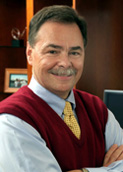
There's no escaping the issue of health care reform this summer. It's on the front page of every newspaper and it leads every broadcast of the evening news—and rightfully so. Whatever your views on the potential solution to the crisis, we can all agree that there is an urgent need to improve the way we deliver health care in this country. Fortunately, we here in the Woodruff Health Sciences Center are in a position to help shape and lead that change.
In fact, academic health centers (AHCs) like ours have a long tradition of innovation in health and health care. The intersection of our four-fold mission of research, education, health care, and public service presents unique opportunities for identifying and implementing advances in health outcomes, safety, cost-benefit, and patient satisfaction.
The wide range of academic and clinical health professionals in AHCs work across a multitude of disciplines to provide cutting-edge, highly specialized patient care; to treat without compensation many of our community's sickest and most disadvantaged patients; to confirm the effectiveness of innovative diagnostic and therapeutic techniques through clinical research; to foster new discoveries in biomedical science and technology and apply them in a clinical setting; and to educate future generations of health professionals who will advance these improvements.
As the traditional homes of innovation in health and healing through research and patient care, and as the major sites of implementing change through education, AHCs like the Woodruff Health Sciences Center have been and will continue to be at the forefront of improving health care.
To learn more about the role academic health centers like the WHSC play in health care reform, please read a chapter that will soon be published in the new book Engineering the System of Healthcare Delivery (IOS Press; William B. Rouse, PhD, and Denis Cortese, MD, editors). The chapter also outlines some of the rationales and processes that underpin many of the initiatives currently under way within the WHSC, including organizational alignment, culture transformation, and funds flow review. These and other initiatives will ensure that we continue to lead the improvement of health care efficacy and efficiency through novel approaches in education, research, and service.
I hope you will find this chapter helpful as we continue transforming health and healing … together.
Please share your thoughts and feedback at evphafeedback@emory.edu.
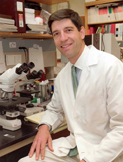 Stuart Knechtle directs Emory's liver transplant program.
Stuart Knechtle directs Emory's liver transplant program.
EUH performs state's first domino liver transplant
Transplant surgeons at Emory University Hospital are the first in Georgia to perform a rare domino liver transplant. The 10-hour procedure took place on July 10 and involved two surgical teams working in adjoining operating rooms.
A liver from a deceased donor was transplanted into Jean Handler, 24, who has suffered since birth from maple syrup urine disease (MSUD), a genetic disease. Handler’s own liver was transplanted into Robert Massie, 53, who was born with hemophilia and had contracted hepatitis C and HIV in the early 80s from donated blood products.
The first transplant in effect cures Handler's MSUD. Because MSUD does not exclusively affect the liver (the disease is caused by a lack of a particular enzyme in all cells of the body), Handler's own liver could be given to Massie because his non-liver cells make the missing enzyme.
Transplant of even a single liver is complex because the liver connects to the large hepatic artery and a network of large veins. The fact that one patient in the domino procedure is both recipient and donor makes the dual transplant especially challenging, requiring tremendous coordination, education, and skill to ensure best outcome. View TV news report.
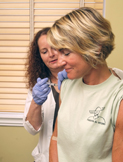 Vaccine volunteer at Emory's Hope Clinic
Vaccine volunteer at Emory's Hope Clinic
New flu website goes live, vaccine trials continue
A new website provides continually updated advisories and other information from Emory's Office of Critical Event Preparedness and Response on both seasonal and avian flu.
Meanwhile, researchers at the Emory Vaccine Center's Hope Clinic continue to vaccinate volunteers in clinical trials of a new H1N1 vaccine. Testing in children began today (Aug. 26), following inauguration of adult trials on Aug. 10. In a subsequent trial, the researchers will test effectiveness of the vaccine with an adjuvant. Emory is one of eight vaccine and treatment evaluation units supported by the NIH to conduct these trials.
In addition to testing safety and efficacy of the H1N1 vaccine, the Emory trial will help determine how it should be given along with vaccine for seasonal flu to make it most effective.
Read more about flu vaccine clinical trials at Emory.
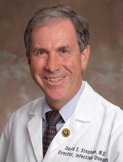 David Stephens is VP for research in the WHSC.
David Stephens is VP for research in the WHSC.
Stimulus funds support 60-plus projects worth more than $13 million
Emory researchers have secured at least $13 million in NIH stimulus support for more than 60 projects (and counting). The American Recovery and Reinvestment Act of 2009 (ARRA), passed by Congress in February, opened up funding opportunities for new and ongoing projects, and Emory has received half of all ARRA grants awarded to Georgia academic institutions thus far.
Examples of stimulus-funded projects include new treatments for epilepsy, biomarkers for Alzheimer's via magnetic resonance, mechanisms of cardiac fibrosis, and pediatric heart development, among others. Read more. Information about stimulus funds received by Emory is archived on a new university website.
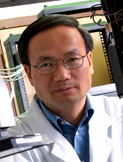 Haian Fu directs the Emory CBC.
Haian Fu directs the Emory CBC.
NCI names Emory to nationwide bio consortium
Emory's Chemical Biology Discovery Center has been selected by SAIC-Frederick (SAIC-F) to be part of the 11-member national Chemical Biology Consortium (CBC). SAIC-F is the prime contractor to the NCI at Frederick, Md.
Efforts of the national CBC are aimed at developing new targeted cancer therapies, with focus on unmet medical needs, such as drugs that are of low interest to the pharmaceutical industry but that could benefit patients significantly.
As one of three specialized application centers in the NCI consortium, the Emory CBC will focus on protein-protein interactions in cancer through assay development and implementation, high-throughput screening, medicinal chemistry optimization, and informatics, with participation of an intellectual property specialist. Read more.
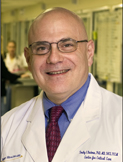 Timothy Buchman
Timothy Buchman
Bio stats:
• Founding director, Emory Center for Critical Care
• Pres., Soc. for Complexity in Acute Illness, 2007-2009
• Pres., Soc. of Critical Care Medicine, 2004
• Chief, Acute and Critical Care Surgery, Wash. Univ. School of Medicine, 1994-2009
• Director, Surgical ICU and Trauma Center, Johns Hopkins, with joint appointments in molecular biology and genetics, 1985-1994
• Fellow, traumatology, Maryland Institute for Emergency Med. Service Systems, 1986-1987
• Internship and residency, Johns Hopkins Hospital, 1980-1985
• MD, Univ. of Chicago, 1980
• PhD, virology, Univ. of Chicago, 1978
Contact:
tbuchma@emory.edu
One in a series of profiles of people in the Woodruff Health Sciences Center
Tim Buchman, who arrived last month as the founding director of the Emory Center for Critical Care (ECCC), first entered trauma surgery by the same route as many of his patients: injured. After a reckless driver plowed into his car, he was wheelchair-bound for part of his residency at Hopkins. The resulting trauma led him to discover in himself what he calls "the rescue imperative." He has been acting on that imperative ever since.
The goal of the new center he leads is to fundamentally change the critical care process to achieve better patient outcomes at lower costs. Emory is starting this process by integrating all ICUs throughout all of Emory's hospitals.
Because critical care is a relatively young discipline (the first physician-led ICU dates back only to the 1950s), ICUs in academic medical centers like Emory sprang up in individual departments like medicine and surgery. Emory's ICUs have done very well there, says Buchman, delivering "right care right now" for patients whose lives literally depend on it.
So what's to change? Not the good stuff, he says.
While existing ICUs at Emory will remain geographically dispersed, the interdisciplinary teams who staff them will be linked under the new ECCC umbrella. That approach, says Buchman, will "standardize and harmonize clinical care, optimizing quality and making it easier for patients' personal physicians to understand and participate in the process."
It also will help fulfill the Emory mantra of discovered here, practiced here, taught here, he says.
The new ECCC that Buchman heads will integrate not just ICUs across Emory Healthcare but also research and training in critical care throughout the WHSC.
In addition to his training as a trauma surgeon, Buchman has a PhD and lab background in molecular biology and a research passion for predictive biology, which he describes as "predictive health on a more immediate time frame." Increasingly, he says, our job as clinicians is to see into the future of each patient and change what we do for that patient accordingly. In critical care, for example, it should be possible now, given current knowledge and data density already in the ICUs, to anticipate which patients will go into shock or have a seizure minutes, even hours, before it happens.
"We want to do for patient care what modern meteorology did for weather forecasting," he says. "It combined unprecedented observational data with a better understanding of the laws of physics and began to allow people to make plans based on what was going to happen."
For the immediate future, Buchman sees his main jobs in the months ahead as explaining the ECCC vision, winning buy-in from the wide reach of individuals essential to its success, and making sure the right team—"the family of choice"—is assembled and fully on board. He uses the word team a lot. "I'm not the dictator of critical care at Emory," he says. "I'm not even the owner. I'm the leader, the coach, not the quarterback."
Buchman is married to Barbara Zehnbauer, a microbiologist he met as a medical student in her lab, and who is now chief at the CDC's Laboratory Practice Evaluation and Genomics Branch. Their daughter, Rachel, is a writer.

• GCC names new scholars at Emory
The Georgia Cancer Coalition recently named 19 new GCC scholars to its roster, including the following at Emory: Carla Berg (public health), Lawrence Boise (hem-onc), Baowei Fei (radiology), Tobey McDonald (hem-onc, pediatrics), Joel Saltz (informatics), and David Schuster (radiology). Read more.
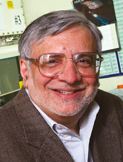 Rafi Ahmed
Rafi Ahmed
• NIH awards $16M for immunology research
The NIH awarded a five-year, $16 million renewal grant to researchers in the Emory Vaccine Center and their collaborators to investigate the human immune response to vaccines in its entirety, from innate and peak responses to development of long-term immune memory. Rafi Ahmed, vaccine center director and Georgia Research Alliance Eminent Scholar, is PI on the grant. Read more.
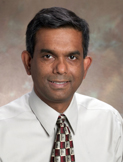 Subra Kugathasan
Subra Kugathasan
• CCFA awards $5M for study of Crohn's in children
The Crohn's and Colitis Foundation of American (CCFA) recently awarded Emory and Children's Healthcare of Atlanta a four-year, $5 million grant to study progression of Crohn's in kids. The purpose of the multi-center study, which will enroll 1,100 children, is to identify biomarkers in blood or stool to predict risk for complications. Subra Kugathasan (pediatrics) is the study PI. Read more.
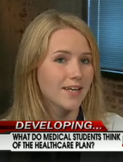
• Emory students weigh in on health care reform
Sarah Strunk (left) was among several Emory medical, physician assistant, and public health students and residents who were featured recently in a three-segment Fox News Channel discussion hosted by Jonathan Serrie on health care reform. See video clips 1 and 2.

• WHSC launches blog to promote ideas, innovation
The WHSC recently launched a blog, "Emory Health Now," which highlights research, ideas, expert commentary on important news of the day, and other information in an informal, nimble, and concise format. You can access the blog from the WHSC's site at emoryhealthsciences.org.
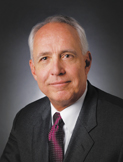 Darrell Kirch
Darrell Kirch
• Please note these dates
- Future Makers: Darrell Kirch, president and CEO of the Association of American Medical Colleges, will be the speaker at the next EVPHA-sponsored Future Makers lecture on Thurs., Oct., 29, in the WHSCAB auditorium at 5 p.m. Read his thoughts on what academic medical centers have to do with health care reform in a recent article in Emory Health magazine.
- Free screening: The Emory Winship Cancer Institute is offering a free breast health screening on Tues., Oct., 6, from 4:30 to 6:30 p.m. This event is free, and refreshments will be provided. To register, please call Emory HealthConnection at 404-778-7777.
 CVMAR at Yerkes field station
CVMAR at Yerkes field station
• Recent recognition
- The new Clinical Veterinary Medicine Administration Research Building (CVMAR) at Yerkes Research Center Field Station in Lawrenceville has received LEED Gold certification, one of three Emory buildings so designated. The CVMAR earned points for site sustainability and water and energy efficiency. This building is the cornerstone for new programs using social colonies of genetically typed nonhuman primates to help researchers understand the interaction between genetics and environment and the roles they play in human health and disease.
- Both Tahsin Kurc (biomedical engineering) and Joel Saltz (Center for Comprehensive Informatics, or CCI) received a recognition award at the caBIG annual meeting last month for contributions to the caGrid Knowledge Center. The Emory CCI team demonstrated work in tissue microarray at caBIG, a major NCI initiative.
- Radiation Oncology was named by Imaging Technology News as a "top five" radiation therapy center to watch in 2009. Read more.
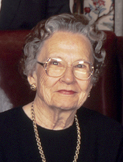 Grace Crum Rollins
Grace Crum Rollins
• In memory
Grace Crum Rollins, whose generosity led the Rollins School of Public Health to become one of the nation’s premier schools in its field, died on Aug. 8 at age 98. In 1994, the Grace Crum Rollins Building became the permanent home for the school that Emory named for her extraordinary family.
Mrs. Rollins was the widow of businessman O. Wayne Rollins. The couple became involved with Emory through the Candler School of Theology and Wayne’s role as a university trustee. With a lead gift to the medical school, they enabled construction of the O. Wayne Rollins Research Center. Later, Wayne volunteered his support for a public health building but died unexpectedly in 1991. After his death, Grace and her sons Gary and Randall (current and emeritus trustees, respectively) fulfilled his promise by contributing $10 million for construction.
Other gifts followed, including a $50 million lead gift through the O. Wayne Rollins Foundation for the Claudia Nance Rollins Building, which is named for Wayne’s mother and will open in 2010.
When the Rollins family first invested in public health at Emory, the school had only 20 faculty and 500 graduates. Today, it has 200 faculty and more than 5,000 alumni in 90 countries. "Our faculty, students, and alumni are part of her legacy," says RSPH Dean James Curran. Read a recent blog about Mrs. Rollins.

